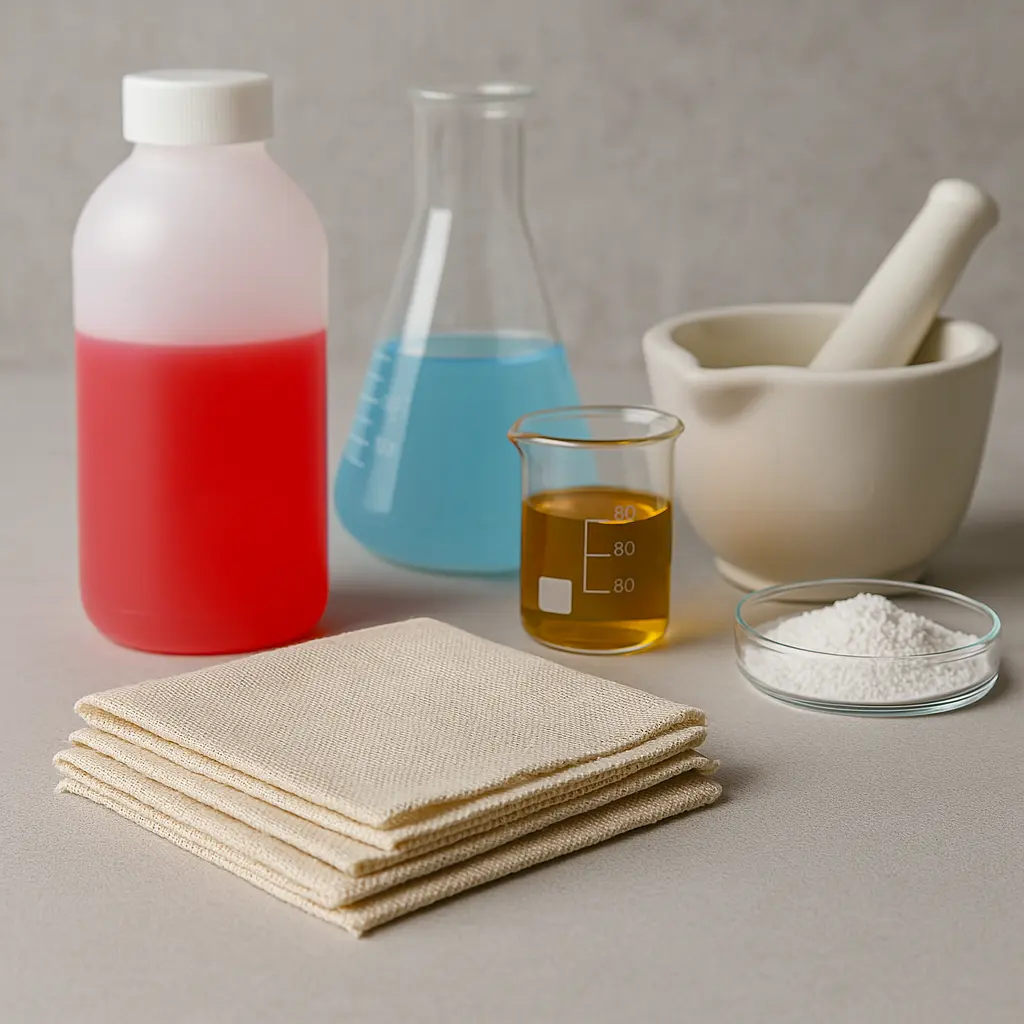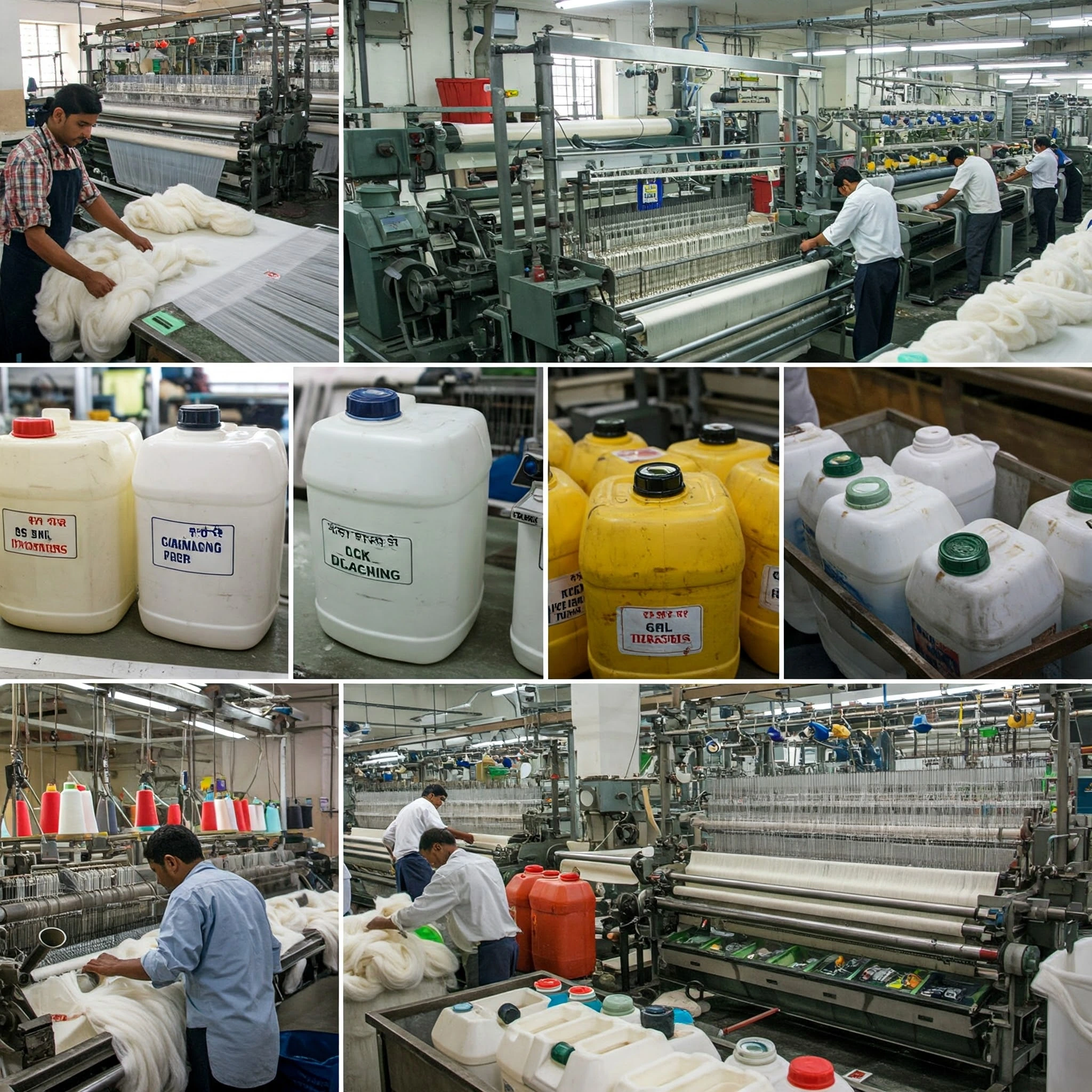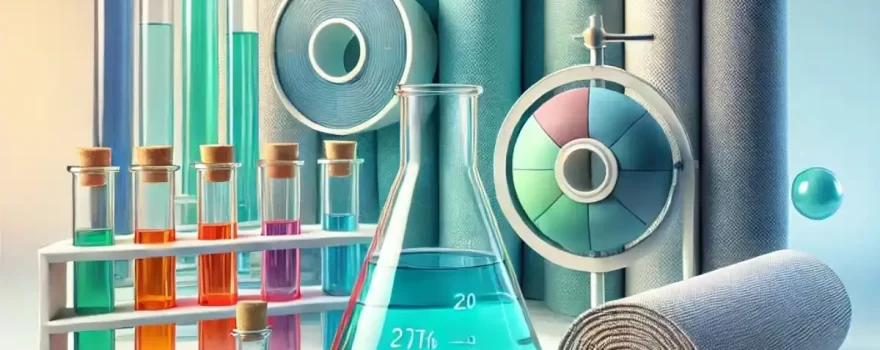
Technical textiles are no longer a niche market. They’re revolutionizing industries, from automotive to aerospace. But what makes these textiles so special? It’s the magic touch of technical textile chemicals.
These aren’t your ordinary dyes or finishes. They’re specialized compounds that impart specific properties to textiles, making them fire-resistant, water-repellent, antibacterial, or electrically conductive. Imagine a fabric that can shield you from harmful UV rays or one that can self-clean. That’s the power of technical textile chemicals.
In the following sections, we’ll delve deeper into the world of technical textile chemicals, exploring their diverse applications, the science behind them, and their impact on our daily lives.
Table of Contents
Understanding the Types of Technical Textiles
Technical textiles aren’t a one-size-fits-all solution. Different types are present, each specifically adapted for certain applications. Let us take a closer look at some of the significant categories:
- Protective Textiles: These are the unsung heroes, safeguarding us from hazards like fire, chemicals, and radiation. Think of firefighter gear, bulletproof vests, and protective clothing for industrial workers.
- According to a report by Allied Market Research, the global protective textiles market was valued at $22.9 billion in 2020 and is projected to reach $35.6 billion by 2027, registering a CAGR of 6.7% from 2021 to 2027.
- URL: https://www.alliedmarketresearch.com/industrial-protective-clothing-market
- Medical Textiles: From surgical drapes to wound dressings, medical textiles play a crucial role in healthcare. They must be sterile, biocompatible, and often, antimicrobial.
- The Journal of Biomedical Materials Research Part A has released a study indicating that the global market for medical textiles is anticipated to grow at a compound annual growth rate (CAGR) of 6.5% from 2021 through 2026.
- URL: https://www.ncbi.nlm.nih.gov/pmc/articles/PMC8266694/
- Industrial Textiles: These workhorses power industries like construction, agriculture, and automotive. They’re used for filtration, reinforcement, and insulation.
- Grand View Research, Inc. has reported that the global industrial textiles market was valued at USD 103.8 billion in 2021, and it is forecasted to experience a compound annual growth rate (CAGR) of 5.1% between 2022 and 2030.
- URL: https://www.grandviewresearch.com/industry-analysis/textile-market
- Sports Textiles: Whether it’s a high-performance running shoe or a moisture-wicking sportswear, sports textiles enhance athletic performance. They must exhibit characteristics of being lightweight, breathable, and resilient.
- Each of these types of technical textiles requires specialized chemicals to achieve their desired properties. The variety of these chemicals can include flame retardants, water repellents, and agents that possess antimicrobial properties.
Key Categories of Chemicals Used in Technical Textiles
Technical textiles wouldn’t be what they are without a diverse array of chemicals that imbue them with specific functionalities. Let’s delve into some of the key categories:
Coating Agents:
Coating agents are applied to the surface of textiles to provide properties like water repellency, oil repellency, flame retardancy, and anti-microbial protection.
- Water and Oil Repellents: These coatings form a protective layer on the surface of the fabric, effectively blocking the penetration of liquids. They are essential for both outdoor equipment and medical textiles.
- Flame Retardants: These compounds act to prevent or slow down the onset and dissemination of fire. They are essential for protective clothing and upholstery.
- Antimicrobial Agents: These substances inhibit the proliferation of bacteria and fungi, rendering them suitable for use in medical textiles and athletic apparel.
Binders:
Binders are used to adhere different materials to the textile surface, such as pigments, dyes, or other additives. They ensure the durability and performance of the treated fabric.
- Polymer-Based Binders: These are commonly used to bind pigments and dyes to the fabric, providing colorfastness and wash resistance.
- Latex Binders: These are used to create coatings and laminates, offering water resistance and mechanical strength.
Softeners:
Softeners improve the hand feel and drapability of textiles, making them more comfortable to wear.
- Cationic Softeners: These softening agents possess a positive charge, allowing them to readily attach to negatively charged fibers, thereby enhancing both softness and shine.
- Non-ionic Softeners: These softeners possess a neutral quality, making them suitable for different types of fibers. They provide a softer hand feel without affecting the fabric’s color.
Finishing Agents:
Finishing agents are used to modify the surface properties of textiles, such as wrinkle resistance, crease recovery, and UV protection.
- Wrinkle-Resistant Finishes: These treatments reduce the formation of wrinkles, making the fabric easier to care for.
- Crease Recovery Finishes: These finishes allow the fabric to recover its original shape after being creased or wrinkled.
- UV Protective Finishes: These treatments protect the material from damaging UV radiation, thereby preventing the fading of colors and deterioration.
By carefully selecting and applying these chemicals, manufacturers can create technical textiles that meet the diverse needs of various industries, from automotive to aerospace and healthcare.
Innovative Applications of Chemicals in Technical Textiles

Technical textiles are no longer just about fabric; they’re about function. Chemicals play a pivotal role in transforming ordinary textiles into high-performance materials. Let’s explore some innovative applications:
Flame Resistance
- Fire-Retardant Coatings: These coatings create a protective barrier on the fabric’s surface, preventing ignition and slowing down the spread of flames.
- Intumescent Finishes: When subjected to heat, these finishes expand, resulting in the formation of a char layer that insulates the fabric underneath.
Water Repellency
- Durable Water Repellent (DWR) Finishes: These finishes develop a hydrophobic barrier on the surface of the fabric, which serves to repel water droplets.
- Super hydrophobic Coatings: The surface energy of these coatings is exceptionally low, leading to the phenomenon where water droplets bead up and slide off the fabric.
Antimicrobial Functionality
- Antimicrobial Agents: These compounds hinder the growth of bacteria and fungi, which helps to reduce unpleasant odors and prevent infections.
- Nano-Silver Technology: Silver nanoparticles have strong antimicrobial properties and can be incorporated into textiles to provide long-lasting protection.
UV Protection
- UV Absorbers: These chemicals absorb harmful UV radiation, preventing damage to the fabric and protecting the wearer’s skin.
- UV Reflectors: These chemicals reflect UV radiation, minimizing its penetration into the fabric.
Other Innovative Applications
- Self-Cleaning Textiles: These textiles are treated with chemicals that break down dirt and stains, making them easy to clean.
- Smart Textiles: These materials are designed to perceive and respond to environmental stimuli, such as variations in temperature, humidity, and light levels.
- Conductive Textiles: These fabrics possess the ability to conduct electricity, facilitating numerous applications, including wearable electronics and intelligent apparel.
By utilizing chemical innovations, technical textiles are at the forefront of progress and are transforming the landscape of materials science.
Role of Technical Textile Chemicals in Sustainability
The textile industry, including the technical textile segment, has long been associated with environmental concerns. A notable transformation is taking place within the industry, propelled by a heightened consciousness regarding sustainability. The role of technical textile chemicals is vital in advancing eco-friendly practices.
Eco-Friendly Chemicals
A fundamental element of sustainable textile production involves the application of eco-conscious chemicals. These chemicals are specifically developed to lessen their environmental impact from the point of production to the stage of disposal:
- Biodegradability: These chemicals can break down naturally into harmless substances, reducing pollution and waste.
- Low Toxicity: They are less harmful to human health and the environment.
- Reduced Water and Energy Consumption: They often require less water and energy to produce and apply.
- Renewable Resources: These materials originate from renewable sources, including plants and microorganisms.
Sustainable Production Processes
The textile sector is increasingly implementing a range of sustainable production methods aimed at minimizing its environmental impact. Among the primary strategies are:
- Water Recycling: The process of recycling wastewater has the potential to greatly diminish both water usage and environmental contamination.
- Energy Efficiency: The integration of energy-efficient technologies can effectively lower the levels of greenhouse gas emissions.
- Waste Reduction: Achieving waste reduction through streamlined production practices and effective recycling strategies.
- Chemical Optimization: A decrease in environmental impact can result from the strategic reduction of chemical usage and the optimization of their application processes.
- Green Chemistry: The advancement and implementation of chemicals that are less harmful to both the environment and human well-being.
The Future of Sustainable Technical Textiles
The future of technical textiles is undoubtedly green. The increasing awareness among consumers is leading to a heightened demand for sustainable products. By embracing eco-friendly chemicals and sustainable production processes, the technical textile industry can contribute to a more sustainable future.
In conclusion, technical textile chemicals can be a powerful tool for sustainable development. By prioritizing eco-friendly practices and innovative solutions, the industry can create high-performance, environmentally friendly textiles that meet the needs of a growing global population.
Advanced Coating and Finishing Techniques
The textile industry is constantly evolving, and with it, the techniques used to enhance fabric performance. The evolution of advanced coating and finishing techniques is reshaping our perceptions and interactions with textiles.
Nanotechnology
Nanotechnology involves manipulating matter at the nanoscale, offering unprecedented opportunities for textile innovation. By incorporating nanoparticles into textiles, we can achieve a range of functional properties:
- Antimicrobial: Silver nanoparticles have potent antimicrobial properties, making them ideal for medical textiles and sportswear.
- Water and Stain Repellency: Nano-coatings can create a hydrophobic surface, repelling water and oil-based stains.
- UV Protection: Nanoparticles can block harmful UV radiation, protecting the skin and the fabric itself.
- Self-Cleaning: Photocatalytic nanoparticles can break down dirt and stains when exposed to light.
Plasma Treatment
Plasma treatment is a versatile technique that involves exposing textiles to a partially ionized gas. This process can modify the surface properties of fibers, improving their adhesion, wettability, and dyeability.
- Surface Modification: Plasma treatment can create functional groups on the fiber surface, enhancing its reactivity and affinity for other chemicals.
- Improved Dyeability: By utilizing plasma treatment, one can achieve improvements in the brightness and color retention of dyed textiles.
- Enhanced Water Repellency: By creating a hydrophobic surface, plasma treatment can make fabrics water-resistant.
Other Advanced Techniques
- Microencapsulation: Tiny capsules containing various substances, such as fragrances, skincare agents, or phase-change materials, can be embedded into textiles.
- Laser Finishing: Precise laser beams can be used to create intricate patterns, textures, and functional properties on textiles.
By harnessing the power of these advanced techniques, the textile industry can develop innovative products that offer superior performance, comfort, and durability. The continuous evolution of technology suggests that we will encounter more significant innovations in the textile field.
Challenges in the Technical Textile Chemicals Industry
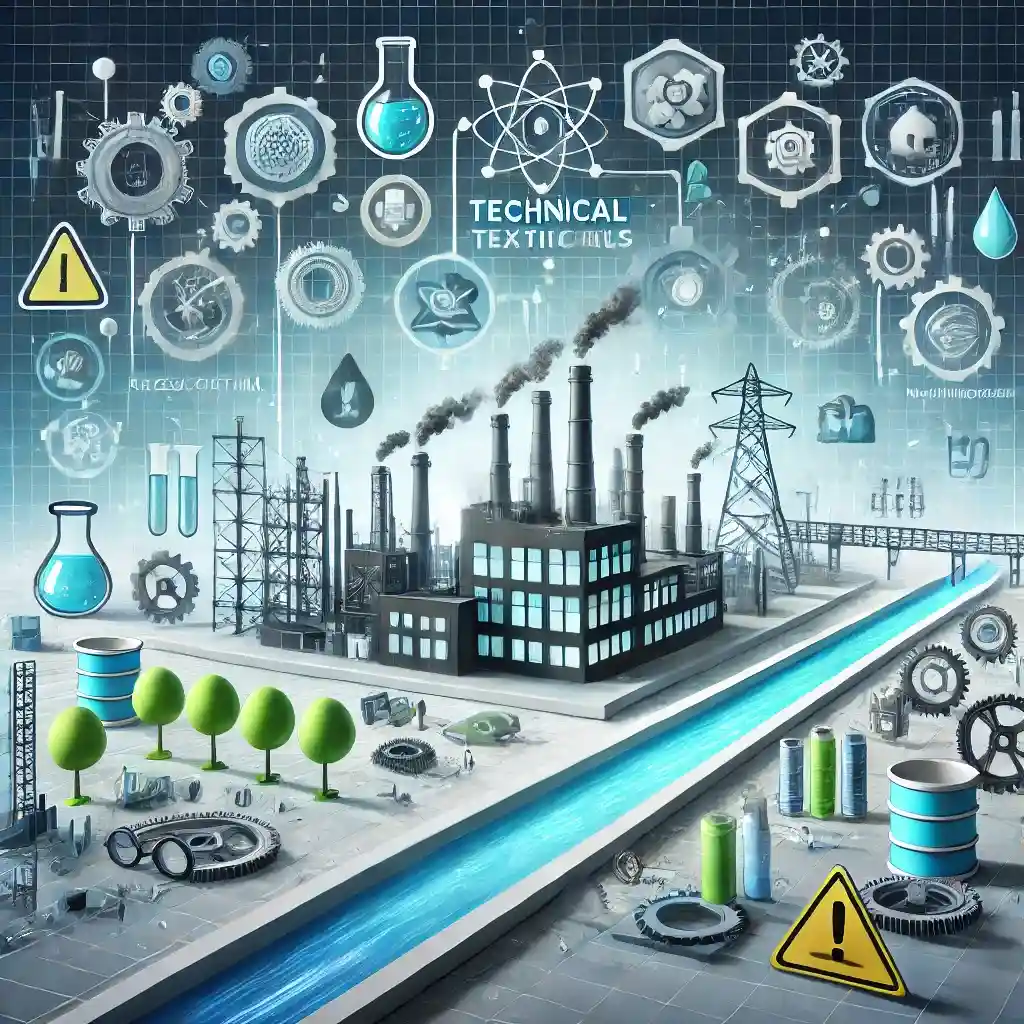
While the technical textile chemicals industry is experiencing significant growth, it faces a number of challenges that must be addressed to ensure sustainable development.
Regulatory Compliance
- Complex Regulatory Landscape: The industry operates under a complicated framework of regulations that address chemical safety, environmental protection, and the safety of consumers.
- Stricter Regulations: Manufacturers and suppliers face significant obstacles due to the escalating strictness of regulations, particularly REACH (Registration, Evaluation, Authorization, and Restriction of Chemicals) in Europe.
- Global Harmonization: The need for harmonization of global regulations to facilitate international trade and innovation.
Environmental Impact
- Chemical Pollution: The handling and disposal of chemical substances can result in environmental degradation, manifesting as pollution of both water and air.
- Sustainable Sourcing: Promoting the sustainable sourcing of raw materials, particularly those that are derived from natural resources.
- Waste Reduction: Decreasing the generation of waste across the production cycle, encompassing the extraction of raw materials and the eventual disposal of the product.
Technical Barriers
Complex Chemical Formulations: Designing advanced chemical formulations that achieve specific performance objectives while ensuring adherence to environmental and regulatory norms.
- Innovation and R&D: Engaging in research and development initiatives is vital for staying competitive and for the formulation of innovative, sustainable solutions.
- Scalability: Scaling up production processes to meet increasing demand while maintaining quality and consistency.
Economic Challenges
- Fluctuating Raw Material Prices: The fluctuations in the prices of raw materials can significantly affect production expenses and overall profitability.
- Global Economic Conditions: Economic slowdowns can result in decreased demand for technical textiles, consequently affecting the growth trajectory of the industry.
- Competition: The intense competition posed by both national and international firms can negatively impact profit margins.
By addressing these challenges, the technical textile chemicals industry can continue to innovate and drive sustainable growth.
Global Market Trends for Technical Textile Chemicals
The international market for technical textile chemicals is undergoing substantial growth, fueled by the escalating need for high-performance textiles across diverse industries.
Key Market Trends:
Rising Demand for Sustainable Chemicals:
- Eco-friendly formulations: The movement towards sustainability has prompted a notable rise in the need for eco-conscious chemicals that lessen their impact on the environment.
- Biodegradable and non-toxic chemicals: These chemicals are becoming increasingly popular as they align with the growing emphasis on sustainability.
Advancements in Nanotechnology:
- Nanoparticle-based coatings: These coatings offer enhanced properties like water repellency, UV protection, and antimicrobial resistance.
- Functional finishes: Nanotechnology enables the development of textiles with specialized functionalities, such as self-cleaning and temperature regulation.
Growth in High-Performance Textiles:
- Sportswear and athletic apparel: The surge in demand for high-performance sports apparel has prompted the innovation of advanced chemical treatments that enhance moisture-wicking, manage odors, and improve durability.
- Medical textiles: The healthcare industry requires specialized textiles with antimicrobial, hypoallergenic, and biocompatible properties.
- Industrial textiles: Industries like automotive, construction, and aerospace rely on technical textiles with flame retardant, water repellent, and abrasion-resistant properties.
Emerging Markets:
- Asia-Pacific: This region is a major growth market for technical textile chemicals, driven by rapid industrialization and increasing consumer demand.
- Latin America and Africa: These areas present considerable opportunities for growth, driven by an increase in disposable incomes and a heightened awareness of the advantages associated with technical textiles.
Key Regions:
- Asia-Pacific: The Asia-Pacific region leads the global market, attributed to its vast population, swift economic development, and a prominent textile manufacturing sector.
- Europe: Europe represents a well-established market that emphasizes innovation and sustainability.
- North America: A significant market for high-performance textiles, particularly in the automotive, aerospace, and medical sectors.
Future Outlook:
The outlook for the technical textile chemicals market appears to be highly favorable. Ongoing innovation, along with a rising demand for sustainable and high-performance textiles, is anticipated to propel market expansion. Significant areas of emphasis include:
- Smart textiles: The creation of intelligent textiles capable of reacting to environmental stimuli.
- Bio-based chemicals: Utilizing renewable resources to produce sustainable chemicals.
- Digital textile printing: Leveraging digital printing technologies to create customized and functional textiles.
By staying ahead of technological advancements and addressing sustainability concerns, the technical textile chemicals industry is poised to play a vital role in shaping the future of materials science and textile engineering.
Impact of Technical Textile Chemicals on Everyday Life
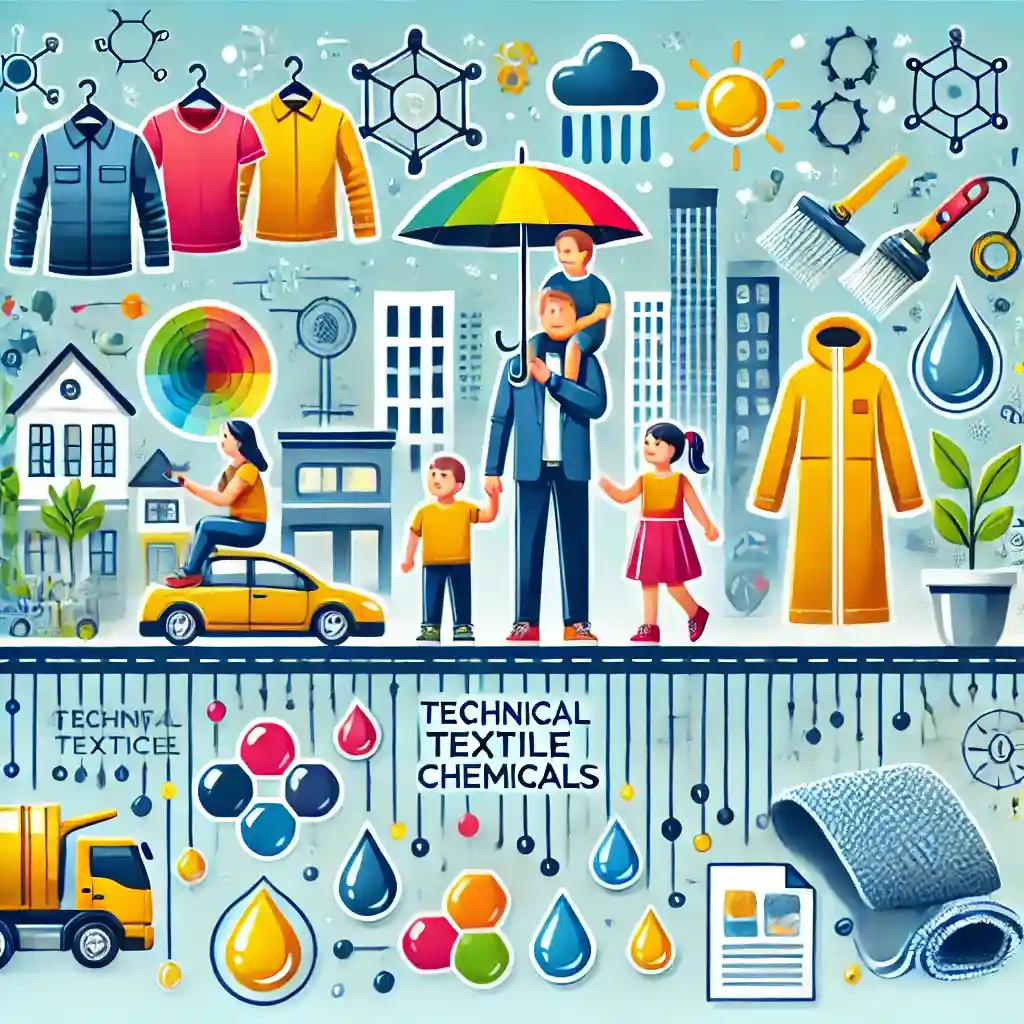
Technical textile chemicals have become an integral part of our daily lives, often unnoticed but significantly impacting our safety, comfort, and overall well-being. Here are a few real-world examples:
Protective Gear
- Firefighter Suits: These suits are treated with flame-retardant chemicals that prevent ignition and slow the spread of flames, protecting firefighters from extreme heat and fire hazards.
- Military and Law Enforcement Uniforms: These uniforms often incorporate bulletproof and stab-resistant materials, as well as flame-retardant and water-repellent finishes.
Medical Devices
- Surgical Garments: These garments are treated with antimicrobial chemicals to reduce the risk of infection.
- Wound Dressings: Advanced wound dressings incorporate antimicrobial and moisture-wicking technologies to promote healing and prevent infection.
- Medical Implants: These implants, such as artificial joints and cardiovascular devices, often have coatings that enhance biocompatibility and reduce the risk of rejection.
Sportswear
- Performance Apparel: Moisture-wicking, breathable, and odor-resistant fabrics are treated with specialized chemicals to enhance athletic performance and comfort.
- Sports Equipment: Protective gear like helmets and pads often use impact-absorbing and flame-retardant materials.
Automotive Industry
- Car Interiors: Upholstery fabrics are treated with stain-resistant, flame-retardant, and antimicrobial chemicals to ensure safety and durability.
- Automotive Components: Technical textiles are used in various components like airbags, seat belts, and filters, often treated with specialized chemicals to enhance their performance.
Home Furnishings
- Curtains and Upholstery: These textiles undergo treatment with chemicals that render them resistant to stains and flames, thereby providing protection against spills and fire risks.
- Carpets and Rugs: Stain-resistant and soil-repellent treatments help maintain the appearance and longevity of carpets and rugs.
By comprehending the importance of technical textile chemicals, we can better appreciate their contributions to our safety, health, and overall comfort. These chemicals play a fundamental role in the creation of innovative and functional textiles that enhance our daily lives in various aspects.
Guidelines for Choosing the Right Chemicals for Technical Textiles
When choosing the right chemicals for technical textiles, it is imperative to adhere to specific guidelines, as this decision can profoundly affect the product’s performance, durability, and safety. Here are some practical guidelines to consider:
Performance Requirements:
- Identify Key Properties: Clearly define the desired properties, such as water repellency, flame retardancy, antimicrobial resistance, or UV protection.
- Consider End-Use: The specific application will dictate the necessary chemical treatments.
- Evaluate Long-Term Performance: Ensure that the chosen chemicals can withstand repeated use, washing, and exposure to environmental factors.
Safety and Environmental Considerations:
- Regulatory Compliance: Adhere to local, national, and international regulations, including REACH, RoHS, and other relevant standards.
- Human Health: Prioritize chemicals that are safe for workers and consumers, minimizing exposure to harmful substances.
- Environmental Impact: Choose chemicals with minimal environmental impact, such as biodegradable and low-toxicity options.
Cost-Effectiveness:
- Initial Cost: Consider the upfront cost of the chemicals.
- Long-Term Cost: Factor in the potential impact on product performance, durability, and consumer satisfaction.
- Processing Costs: Evaluate the ease of application and the required processing techniques.
Supplier Reliability:
- Quality Assurance: Choose suppliers that have demonstrated a consistent ability to provide high-quality chemicals.
- Technical Support: Ensure that the supplier provides adequate technical support and assistance.
- Reliable Supply Chain: Establish a reliable supply chain to avoid disruptions in production.
Testing and Validation:
Laboratory Testing: Conduct rigorous laboratory tests to evaluate the performance of the chosen chemicals.
Pilot-Scale Trials: Test the chemicals on a small scale to assess their real-world performance.
Consumer Testing: Engage with consumers to assess any potential difficulties or sectors that may need enhancement.
Continuous Improvement:
- Stay Updated: Maintain awareness of the latest progress in chemical technology and industry best practices.
- Collaborate with Suppliers: Work in close partnership with suppliers to discover innovative solutions and formulate customized chemical products.
- Monitor Performance: Continuously assess the performance of the selected chemicals to identify potential issues and take necessary corrective actions.
By carefully considering these guidelines, manufacturers can select the right chemicals to produce high-quality, sustainable, and innovative technical textiles.
Future of Technical Textile Chemicals: Innovations on the Horizon
As technology evolves, the scope for creative applications in this field is also on the rise.
Emerging Technologies
- Biomimicry: Inspired by nature, researchers are developing textiles with self-cleaning, water-repellent, and antimicrobial properties, mimicking the characteristics of plants and animals.
- Additive Manufacturing: 3D printing methodologies are making it possible to produce complex textile designs with specialized attributes, which is leading to the emergence of novel functional textiles.
- Internet of Things (IoT): Integrating electronics into textiles can create smart fabrics that monitor vital signs, respond to environmental stimuli, and provide personalized comfort.
Research in Smart Textiles
- Wearable Electronics: The development of flexible and stretchable electronic devices, such as sensors and actuators, is paving the way for smart textiles that can monitor health, track fitness, and provide personalized feedback.
- Energy Harvesting Textiles: Research is underway to develop textiles that can harvest energy from various sources, such as sunlight, body heat, and mechanical energy.
- Self-Healing Textiles: Innovative finishes and coatings are being created to facilitate self-repair in textiles, which contributes to their extended lifespan and lessens waste production.
Potential Breakthroughs in Chemical Applications
- Sustainable Chemistry: The industry is increasingly focusing on developing eco-friendly chemicals with reduced environmental impact.
- Advanced Functional Coatings: The advancement of coating technologies is allowing for the production of textiles with superior attributes, such as resistance to flames, water repellency, and protection against UV rays.
- Bio-based Chemicals: The adoption of renewable resources, including plant-derived materials, for chemical production is increasingly becoming popular.
With the rising demand for high-performance, sustainable, and innovative textiles, the outlook for technical textile chemicals appears promising. By embracing technological advancements and prioritizing sustainability, the industry can significantly contribute to the creation of a more progressive and eco-friendly future.
Conclusion
Technical textile chemicals are the unsung heroes behind the performance, durability, and safety of countless products we rely on daily. From the flame-resistant gear of firefighters to the antimicrobial properties of medical textiles, chemicals play a pivotal role in enhancing the functionality of these materials.
When considering future trends, it is obvious that the appetite for innovative and environmentally friendly textile solutions is expanding. By embracing emerging technologies, prioritizing eco-friendly practices, and fostering collaboration between industry, academia, and government, we can unlock the full potential of technical textile chemicals.
The future of technical textiles is bright, and chemicals will undoubtedly be at the forefront of driving innovation and shaping a more sustainable world.
Read more: Specialty Textile Chemicals: The Secret Sauce of the Textile Industry
